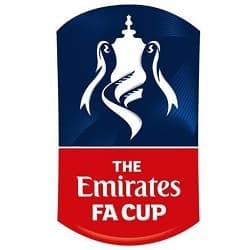Welcome to our guide to Emirates FA Cup fixtures. In his article we’re going to explain everything that you need go know about the matches in this famous cup contest. We’re going to discuss how FA Cup fixtures today are televised, how the draw works and the format of the competition. Read on to learn everything you need to know about the fixtures in the most prestigious cup in English football.
Explore Our Football Betting Sites
FA Cup Fixtures on TV
There have been FA Cup fixtures on TV since way back in 1937. The BBC were the first broadcaster to show the competition and then coverage was shared with ITV, when that channel launched in 1955. ITV and the BBC continued to share coverage of the competition on terrestrial TV until 1988, when the BBC secured exclusive coverage.
That coverage on the BBC ran from 1988 to 1997, with games being shown from the third round, though subscription services such as BSB and then Sky showed a match from the first and second round from 1990 onwards.
Then in 1997, ITV and Sky took over live coverage, with two matches each per round and the BBC showing highlights in Match of the Day. From 2002 to 2008 it was the BBC and Sky that shared coverage, before ITV secured terrestrial rights between 2008 and 2014, with Setanta as their satellite and cable partner.
Changing Face of TV Rights
Setanta went into administration in 2009, with ESPN replacing them between 2010 and 2013 and then BT taking the reins in 2013-14. BT and the BBC partnered to provide FA Cup coverage between 2014 and 2021. From 2021 onwards, BBC and ITV have had the rights to today’s FA Cup fixtures.
The competition is back on free-to-air terrestrial television and it’s a very different BBC and ITV broadcasting the FA Cup than was once the case. Now both the BBC and ITV have a number of different channels to spread the games across, as well as live streaming options.
With live coverage of games starting in the first round, with multiple matches being shown from each round, fans of the FA Cup and football betting sites have never had it so good when it comes to television coverage.
FA Cup Fixtures Draw
Each round of fixtures in the FA Cup is determined by a random draw. Every team involved in that round of the draw are assigned a number. Balls are drawn that feature these numbers, to determine which teams are playing each other.
The FA Cup fixtures draw for the extra preliminary and preliminary rounds is made in July, with fixtures played in August, between clubs in levels eight, nine and ten of the football pyramid. Level seven clubs enter in the first qualifying round, with level six clubs entering in the second qualifying round, before the teams from level five, the National League (formerly Conference), enter in the fourth qualifying round.
Up until that point only non-league sides are involved in the draw. At the First Round proper, League One and League Two teams enter and compete against the non-league teams that have made it through to that stage. The draw is made in October, with fixtures played in November.
Big Teams Come in for Third Round
The Second Round sees the draw made in November, with the games played in December, with the matches still being comprised of fixtures between League One, League Two and non-league teams.
It’s not until the Third Round – drawn December and played January – that the big boys join in. We’re talking about Championship sides and Premier League teams entering the fray. This makes that particular stage a big deal.
When you have big clubs entering the competition, Man Utd FA Cup fixtures for example, these receive way more exposure. Including the Third Round, there are five rounds to whittle down the teams to the two finalists. All along the way the FA Cup draw for each round is an important part of the process.
Once the FA Cup draw was made on a Monday afternoon after the weekend fixtures and was broadcast on radio rather than television. Now the draws from the First Round proper are all televised. Often it’s done before or after one of the last televised games of the round.
FA Cup Fixtures Odds & Latest Outright Betting
There is always an outright market on FA Cup betting sites about which team will lift the trophy at Wembley come the end of the season. This is due to the popularity of wagers on the competition. Here are the latest FA Cup odds for the current campaign:
| Team | FA Cup Winner Odds | Bookmaker |
| Manchester City | 7/2 | |
| Liverpool | 7 | |
| Chelsea | 13/2 | |
| Tottenham Hotspur | 9/1 | |
| Manchester United | 10/1 | |
| Arsenal | 12/1 | |
| Newcastle United | 20/1 | |
| West Ham United | 20/1 | |
| Leicester City | 25/1 | |
| Aston Villa | 25/1 |
FA Cup Fixtures and Results
There are two main aspects that serve to make the FA Cup a very special competition. The first is that it’s open to so many levels of teams. Sides from the tenth tier of the English football pyramid compete in the competition and in theory could make it to the FA Cup final at the home of the England national team and the sport itself, Wembley Stadium.
In reality, non-league teams do not expect or even hope to reach the final of the FA Cup. Instead they desire to face a big club and have Premier League predictions that they hope come true. When such matches are televised, it delivers a massive cash windfall to non-league clubs, while if it is an away match, there can also be huge shared gate receipts.
The second aspect that makes the FA Cup so special is that it is a straight knockout competition and completely unseeded. The Third Round can not just see instances when small clubs are playing big clubs, but may also have the two favourites playing against each other. Any team that is still in the competition, can face any other.
Despite the fact that some Premier League clubs are extremely wealthy and have squads packed with internationals, surprises can still come in FA Cup fixtures today. Big clubs regularly get knocked out in the early rounds. Sometimes in games in which they are widely expected to progress.
Giant Killings
When a small club defeats a much bigger one in the FA Cup, it’s known as a giant killing. There have been some very famous examples over the years. Non-league Hereford’s victory over Newcastle in 1972 always springs to mind, with Ronnie Radford scoring a scorcher from long distance, which lead to the crowd invading a very muddy pitch.
Just the year before in 1971, the then very successful Leeds United were beaten by Colchester. In 1992, just months after winning the old First Division, Arsenal were knocked out by Wrexham, who had finished bottom of the previous season’s Fourth Division.
Then in 2003, an Everton side that would finish seventh in the Premier League, were defeated by a Shrewsbury side that were relegated from the Football League that season. It’s fair to say that interest in the FA Cup is not quite what it was, but the hunger for a giant killing remains.
In an era where money rules football, seeing the big clubs get the occasional bloody nose, is always appreciated by football fans, unless of course it’s your team! FA Cup final winners not only qualify for the following season’s UEFA Europa League but contest the next FA Community Shield against the Premier League winners.







